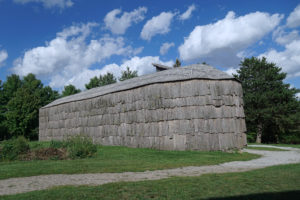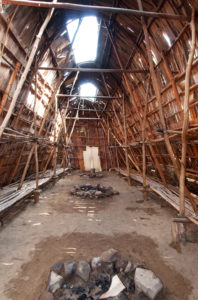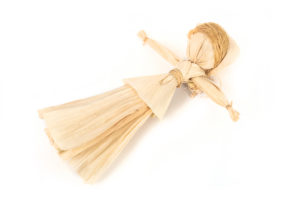Read the Following Selection
Read the following selection, or click on the play button below to listen aloud.
Farmers of the Eastern Woodlands
On the shores of Ontario’s Great Lakes and the St. Lawrence River in southwestern and south-central Ontario lived the Farmers of the Eastern Woodlands. These peoples included the Haudenosaunee (Iroquois), Neutral, Tionontati (Petun), Wendat (Huron), and others. The word “Ontario” comes from the Iroquois word “Onitariio,” which means “Beautiful Lake.”
Palisades and Longhouses

An authentic reproduction of an Iroquois longhouse
Because the land these Eastern Woodlands peoples farmed was so fertile, they didn’t move around, as many other First Nations did. Instead, they stayed where they were and became farmers.
These peoples lived in villages with as many as 1,500 people in them. Each village was surrounded by walls known as palisades. These were rows of posts with sharp points, and there could be as many as three rows around a single village. Some of these settlements had platforms or watchtowers on the palisades so that sentries could keep watch for attacks from enemies.

Interior of a longhouse
These Eastern Woodlands people lived in longhouses, with between 20 and 200 in a village. Each home was a long, rectangular building with a rounded roof—it looked a little like an upside-down basket. Wooden poles formed the frame of the longhouse, which was then covered with tree bark.
The Three Sisters and Other Foods
Farmers of the Eastern Woodlands were known for preparing their fields for planting by burning down the trees and brush on the land and letting the ash fertilize the soil.
These farmers mainly planted crops known as the Three Sisters: corn, beans, and squash. The Iroquois told stories about these crops. The Corn was righteous and stood tall and straight. The shy Bean clutched the Corn’s legs, while the Squash, spreading about on the ground, was the troublemaker.

Three Sisters
Despite their differences, the Three Sisters worked together. The corn provided support for the beans, the beans added nitrogen to the soil to enrich it, and the squash leaves shaded the ground to keep moisture in and weeds out.
Corn was a very important crop because it could be dried and made into a soup to feed a village throughout the winter. Some groups even had an early type of popcorn! The husks from the corn were woven and braided to make dolls, masks, mats, and slippers.
The Eastern Woodlands peoples also gathered bark, berries, herbs, and sunflowers to eat. In the spring, they collected the sap of maple trees and boiled it to make maple syrup or maple sugar. They also hunted deer, rabbits, and water birds, and they fished the rivers and lakes.
Staying Warm

A doll made from corn husk
The Eastern Woodlands farmers wore clothes made from fur and animal hides, as well as from corn husks. For sewing, they used needles made from deer bones, and thread made of animal tendons or fibres from elm bark.
Men wore skirts, or kilts, made of leather in the summer and leggings in winter. Women wore deerskin dresses often belted at the waist. They also wore leggings in the winter, as well as a warm skirt.
Now, show what you know!
Complete some questions about the reading selection by clicking “Begin Questions” below.









